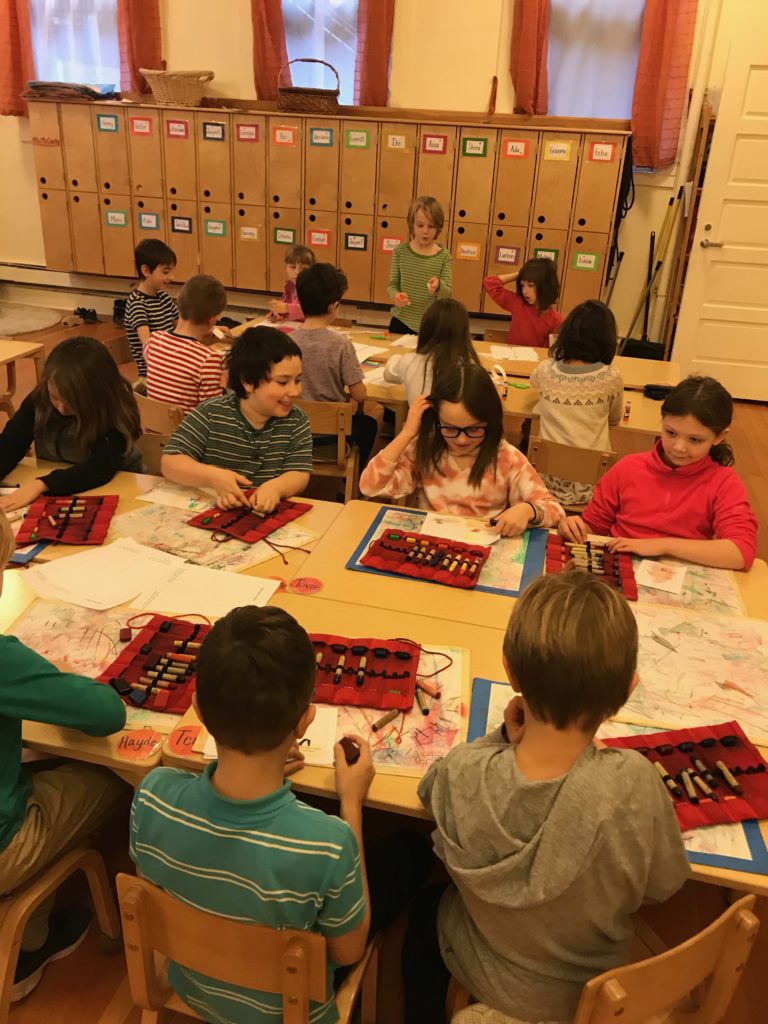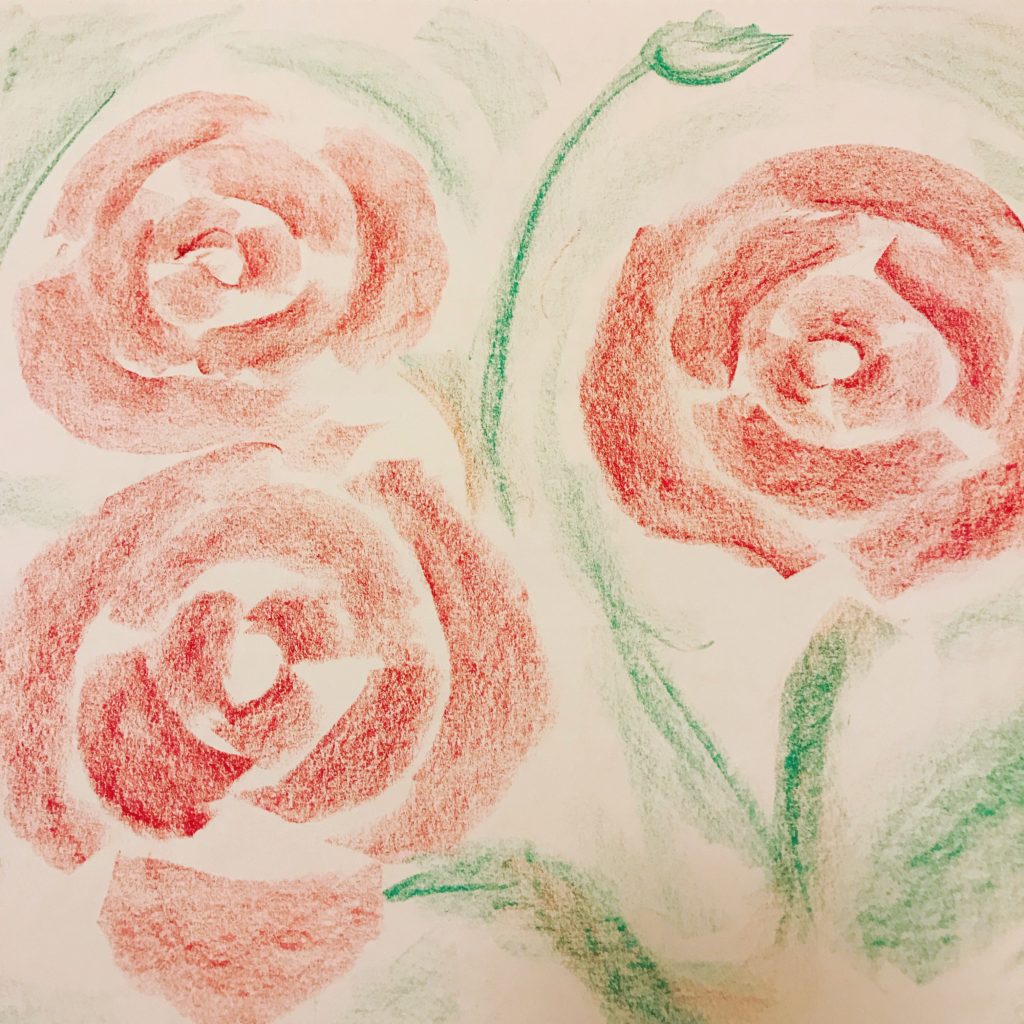It’s been awhile since I’ve given an update here, so I thought I’d take a few minute to let you all know what’s happening in 2nd grade these days.

As I wrote in a recent post, we’re continuing to work hard on our “kid writing” and the 2nd graders are learning so much from the experience. I’m over the moon with their progress. (Click through to read all about the format and rhythm we use for this writing. At this point in the year we’ve settled right in and it’s almost automatic!
Saint Stories
I had intended to work through phonics rules with the stories of the fables as our medium right through the Thanksgiving break, but around the second week of November it felt like the second graders (and their teacher) were craving more substantial stories, like the fairy tales we heard last year. There is a time and place for flexibility, so I switched to Saints, knowing that December (when I had planned it) would be so busy, we could likely use more time to dive into those stories.

I’m so glad I switched. The stories are so much more satisfying and just what the second graders are needing right now.
One of the things I love about my sweet second graders is that they are still so open-hearted. I can tell them to “think of your friend with light in your heart” or that a character in one of our stories “went to do the work that God wanted him to do” and these phrases have meaning for them. Now, I’m not so naive to be blind to the fact that it is entirely likely that a second grader or two knowingly rolls their eyes when I say these things. But most of them do not. They’re sweet and they like that I acknowledge this about them by using language like this with an expectation of common understanding.
Before writing this post, I took a look back to remember what we were doing this time last year in first grade and I remembered with fondness the reverence of our first vowels block. There is something about this time of year that feels so sacred and introspective. Our current block resonates just as beautifully.
If you happen to be looking for a resource to teach that first grade vowels block, I wrote up my lesson plans in a curriculum guide — First Grade Language Arts #2 The Vowels. Lots of people have found it helpful.
Saints vs. Heroes
In my summer training, several of our teachers emphasized the importance of telling stories of the actual saints, rather than making the block about “saints and heroes.” The main idea is that the stories we tell should be of individuals who have a timeless quality — their saintliness is not connected intrinsically to the time in which they lived.

Now, you could make an argument, I suppose, that everyone, Catholic saints included, is impacted by the time in which they lived, and this is certainly true. I’ve had a hard time putting into words why I would tell the story of St. Martin during this block, but not the story of Martin Luther King, Jr. But when I prepare to tell a story, or contemplate an individual biography, I get a feeling for whether they fit in this second grade block. The stories of the saints feel more like fairy tales than historical biographies. The individuals represent archetypes and stand apart from the specifics of their individual stories.
But what about the religious aspect?
As I prepared for the block, I resolved to have no difficulty with the religious aspect of the stories. At the Waldorf school we tell stories from so many different cultures and religions, why should I shy away from the Christian stories, just because they dominate our culture and bring about such strong reactions?
But as I’ve told them, I’ve found myself getting creative with my language to avoid some of the strictly Christian language. “Jesus” translates to “a child of God” or “light” or “love.” “Sin” becomes “pain.” I’ve avoided the term “miracle” and instead I’ve described an environment where the divine was clearly present. The symbol of the cross has sometimes entered my stories because many recognize it as indicating a place of God. I’ve made these adjustments in my stories not because I’m avoiding Christianity, but because I want to use language that is descriptive and has meaning for my students.
For example, if I were to use the name Jesus, even my sweet second grade students would have a reaction based on their previous experiences. Some would think of church. Others would think about how some people go to church and learn about Jesus, but they don’t. My Jewish students might have an even more complex reaction. I want my students to know that every story I tell is for them, so the last thing I’d do is use language that excludes someone. Every one of my students can connect with the phrase “child of God.” (Most of them probably think it is a phrase applies to themselves!)

These changes that I’m making happen in the moment, as I’m telling the story, and I’ve surprised myself with phrases that somehow don’t seem right just moments before I utter them.
Which stories?
So, as it happens, I’m telling very traditional saint stories.
- Saint Christopher
- Saint Odilia
- Saint Martin
- Saint William Firmatus
- Saint Nicholas
- Saint Lucia
- Saint Brigid
- Saint Isidore
I have a few non-traditional saints from other cultures on my list, as well.
- Guru Nanak
- Dhruva
- Asenath Barzani (the first female rabbi)
- Joseph Merrick (the “elephant man”)
I’ve been working on developing that archetypal feeling about these last four stories and haven’t told them yet. I may end up saving them for later in the grades.

Phonics?
Yes, we’re continuing our work with phonics, using these stories as a backdrop. We spent the first couple of weeks working solidly with the silent e, which is a rule that is review from last year, but we needed the practice.
My approach with the phonics during this block is quite a bit different, though. With the fables it was very easy to embed the phonics lesson in the story. With so many fables to choose from, I found it quite easy to find words that matched the rule and choose stories accordingly.
With this block, the story is leading, and the stories are so meaningful, I’m not compromising the language, just so I can fit a phonics rule in. Instead, I’ve been doing some stand-alone phonics practice during main lesson. The content runs alongside the saint stories, but they’re just not woven together so beautifully. It’s a sacrifice I’m willing to make for the sake of those powerful stories and their strong images.
Seasonal Artistic Work and Resources
The time of year is just perfect for these stories and there is beautiful music coming from our voices and flutes. Our daily flute playing has been a bedrock of strengthening rhythm since the beginning of the year. I’ve got quite a skilled little group of flute players.
I’m really happy with the resources I’m using for this block.
- The Giant at the Ford by Ursula Synge (My primary resource, out-of-print but an absolute goldmine. If you find it, buy it.)
- The Stories of the Saints by Siegwart Knijpenga
- The Waldorf Teacher’s Companion to the Pentatonic Flute by John Miles
That’s all for now. I’d love to hear your thoughts about the saint stories in 2nd grade. Leave them in the comments.




Leave a Reply